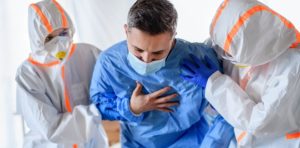Going Viral with COVID-19 by Dave Trecker
A lot has been said about the SARS-CoV-2 virus and COVID-19, the terrible disease it caused. We’ve had mountains of reports, nightly TV briefings and analyses from experts of every stripe. So you may already know everything there is to know. If so, there’s no need to read on. If not, here’s a quick primer.
• First off, what is a virus? It’s a microscopic particle that replicates in living cells. It’s made up of a genetic material like RNA wrapped in a protein coating and sometimes encased in a fatty substance called a lipid. When it enters the body, the virus invades a healthy cell, transfers its genome and reproduces.
• How long before you know you’re infected? With SARS-CoV-2, the incubation time before symptoms appear ranges from two to 14 days. Symptoms, caused by the body’s immune system fighting back, include a cough, shortness of breath and sometimes a sore throat and mild fever. In many cases the infected individual has no symptoms at all.
• What’s the danger? If the virus continues to multiply, it can move into the lungs, causing the immune system to overreact. This can lead to swollen airways and inflamed air sacs, in turn causing further restriction of oxygen intake, fluid buildup and pneumonia.
• How does it spread? SARS-CoV-2 spreads through the air, by interpersonal contact, and from hand-to-mouth exposure after touching infected surfaces, where the virus can live for up to 48 hours. Because this virus is very infectious and spreads rapidly, officials have banned large gatherings. On a person-to-person basis, we are told to keep a distance of at least six feet because droplets from coughing or sneezing cannot travel that far. Shaking hands is also taboo. Elbow bumping is the new form of greeting.
• How is the virus killed? It’s neutralized by disrupting the outer coating and deactivating its genetic core. You can accomplish this by wiping down infected surfaces with a strong disinfectant and by washing your hands with soap and water. The active ingredients – alcohols, oxidants and most surfactants – usually do the job. If the virus enters the body, your immune system takes over and antibodies disrupt the spread. In most cases those infected are either asymptomatic or shed their symptoms and fully recover. In more severe cases, treatment is needed.
• Can the virus mutate? Yes. But to date the mutations have been slow, causing only small variations in the strain. That bodes well for developing a treatment.
• How do the treatments work? Medicines being tested for COVID-19 function by boosting your immune system with antibodies from recovered patients or, in the case of antiviral drugs, by incorporating themselves into the genomes during the replication process, breaking the chain reaction and stopping spread. Once shown to be effective, drugs or antibody-based therapies could be on the market in a matter of months or sooner.
At this writing, several quinoline derivatives have shown promise in China, France and the United States for lessening or
eradicating symptoms. Because these are available drugs approved for other indications, they could be put to use almost immediately.
The long-term answer is a vaccine. Historically, vaccines have conferred mass immunities to serious diseases like influenza,
polio, chicken pox and others. Unfortunately, development and manufacture of a COVID-19 specific vaccine will take at least a
year. But good progress is being made. There’s every reason to be optimistic. American science has never let us down.

Dr. Trecker is a chemist and retired Pfizer executive. He lives in Naples.



Leave a Reply
Want to join the discussion?Feel free to contribute!